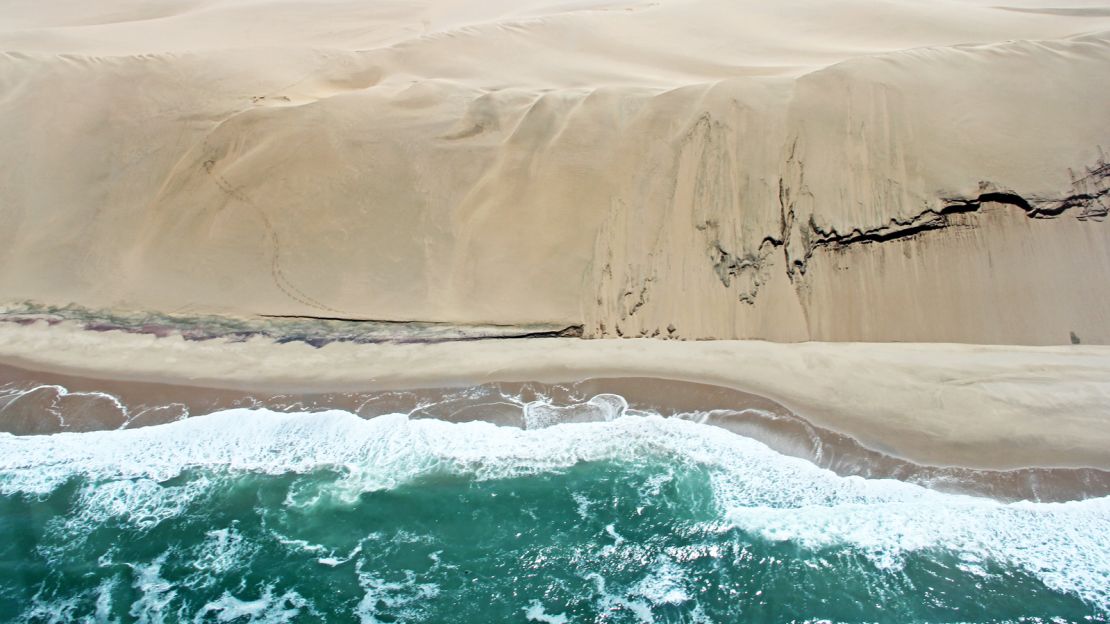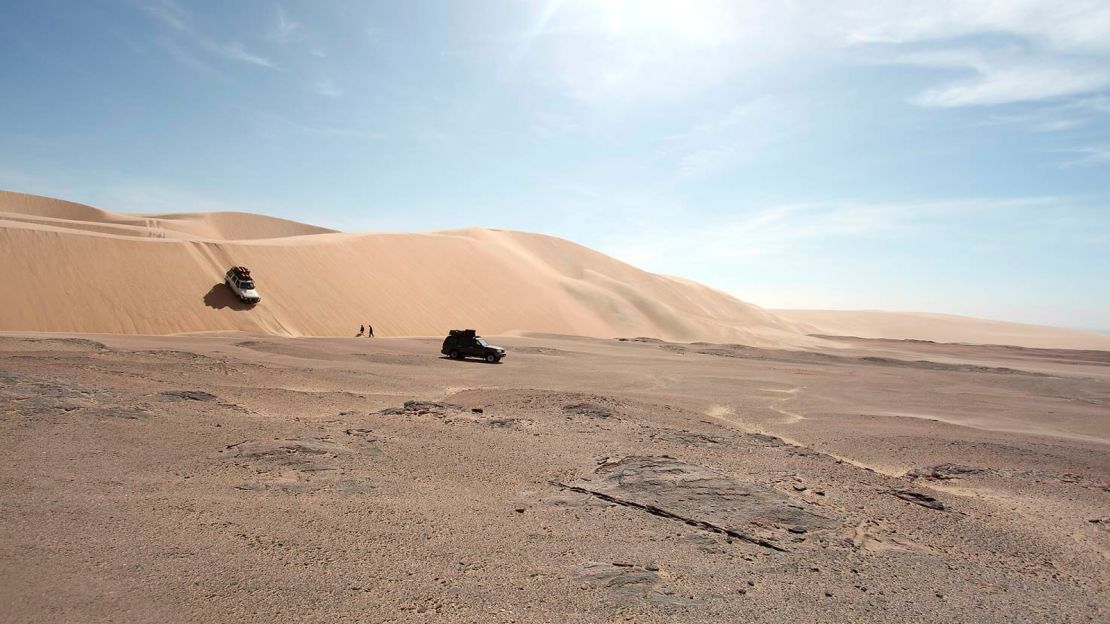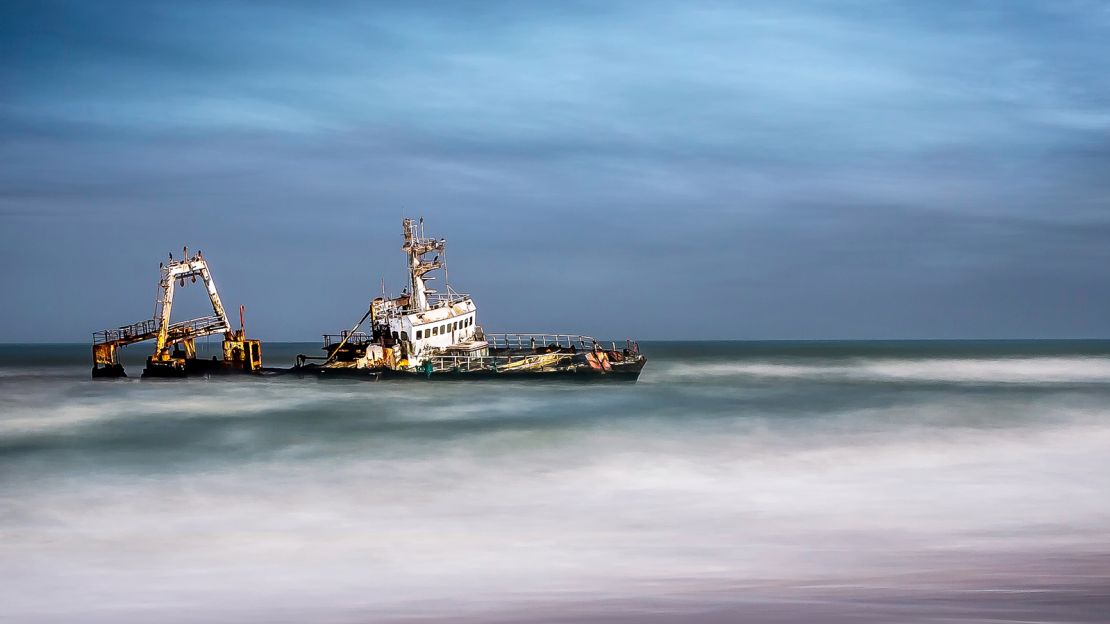It seems more like a mirage than real life – lions stalking seals along a dazzling white sand strand that wouldn’t look out of place in the Caribbean.
But the sand dunes towering a hundred meters (300 feet) behind the shore and the fact there’s nothing man-made – other than shipwrecks – for a hundred miles in every direction indicate that there’s something very different about this section of Namibia’s 1,570 kilometer coastline.
That’s the allure of the Skeleton Coast, a destination that blows away preconceived notions about what Africa should be.
Where the unexpected is a daily occurrence, and civilization is practically nonexistent.
It’s probably as close as our planet gets to the mythical “end of the Earth.”
Harsh environment

Stretching 500 kilometers between the old German colonial town of Swakopmund and the Angolan border, the coast is virtually uninhabited and thoroughly untamed.
The seaboard takes its name from the animal bones scattered across its endless strands and the hundreds of ships that have wrecked there over the centuries.
Lions, hyenas and other predators wander the shore in search of maritime meals.
Elephants are sometimes seen wading into the waves and 11 shark species patrol the offshore waters.
Among the other creatures that inhabit this far shore are leopards, cheetahs and caracal cats, giraffe, gemsbok (oryx) and springbok, neon-pink flamingos and hundreds of thousands of Cape fur seals. Humans are few and far between.
Surfers seek the lengthy breaks and barrels, while others crave the thrill of bashing virgin dunes or the simple solitude of beachcombing a place where yours are the only footsteps in the sand.
Adventure outfitters in Swakopmund organize day trips along the southern part of the Skeleton Coast using kayaks, catamarans, quad bikes and 4x4s.
Treacherous coastline
Namibia's Skeleton Coast: A journey through the 'end of the earth'
Visitors can also hop aboard scenic flights that skim low across the sea and sand.
“Flying the coast is insane,” says Jan Friede, a longtime ranger at Skeleton Coast National Park and now a bush pilot for African Profile Safaris.
Sweeping up from Antarctic waters, the cold Benguela Current flows beside the coast, stoking strong currents and high-energy beaches. Not the best conditions for swimming.
“You don’t want to swim out too far,” warns one local. “The current will take you 200 kilometers out.”
However, it’s ideal for surfers seeking endless summer waves.
Several spectacular breaks – Guns, Cape Cross, Skeleton Bay, Thicklip – attract a small but steady stream of surfers.
Based in Swakopmund, Element Riders offers surfing safaris up the Skeleton Coast, as well as surfing lessons and competitions.
“Surfing this high-energy coastline, one of the least crowded on the planet always includes sharing waves with marine mammals,” says longboarder Rod Braby, former head of the Namibian Surfing Association.

“Respect the locals (Cape fur seals and dolphins) and you will be accepted in the line ups of the best waves on the Skeleton Coast.
“Marine mammals know the waves far more intimately than us.”
Upwelling caused by the Benguela Current also makes the Skeleton Coast one of the best places on the planet for surf or beach fishing.
Offshore waters are rich in African game species like steenbras, kabeljou, blacktail and galjoen.
Sea Ace Fishing Adventures in Henties Bay specializes in surf fishing expeditions along the coast. Wrecks are another hazard – and attraction.
“Life-punctuating adventure”

The skeletons of an estimated 500 ships are scattered along the coast, from wooden Portuguese galleons that were submerged hundreds of years ago to modern steel-hulled vessels.
“Some of them are found behind dunes, far onshore from the sea,” says Friede, who photographed and documented 112 wrecks during his six-year tenure as a park ranger.
“Even if you survived the wreck you were probably doomed. You struggle ashore, overjoyed that you’ve been saved, and then realize that you landed in a desert and probably should have gone down with the ship.”
Many locals say the only way to truly discover the Skeleton Coast is by undertaking a mobile tented safari and driving the shoreline from Swakopmund to Torra Bay or Terrace Bay and then onwards to the Kunene River, which marks the boundary between Namibia and Angola.
The southern portion of the route is surfaced in salt, sand and gravel, the shore devoid of almost anything man-made, other than the occasional fishing camp, shipwreck jutting up through the sand or the lonely stone cross that marks the spot where Portuguese explorer Diogo Cão stepped ashore in 1486.
North of Mowe Bay, the Skeleton Coast is roadless, exceedingly risky and therefore closed to ordinary visitors.
The only way to venture all the way up to the Kunene River is via private outfitters like Africa Travel Resource (ATR) and Wildspace Adventure who have special permission from park authorities and tribal trusts to run 4x4 safaris through one of the most remote regions in all of Africa.
“This is where the great fun starts,” says Marius van Zyl of Wildspace.
“Great colors and breathless views. A magnificent drive for photographers. We camp in the beach, only a few meters from the sea. And it’s only us.”
The drive up the northern coast is “arguably the most remote, adventurous and exciting safaris of their type in Africa at the moment,” says Greg Welby of ATR.
“Only a handful of government permits are available to enter this area each year, so chances are you will have an area of around 16,000 square kilometers all to yourselves,” he adds.
“Days are filled with an endless stream of remarkable experiences, amazing landscapes, desert and coastal wildlife, historic shipwrecks and abandoned diamond mines, as well as visiting authentic Himba villages further inland. A truly life-punctuating adventure.”
Seal colonies and ship wrecks

Scenery varies from lengthy beaches and towering sand dunes, to rocky coastal valleys, oasis-like springs and sandy peninsulas that jut into the South Atlantic.
Along the way are the massive seal colony at Angra Fria, the wreck of the Dunedin Star (which ran aground in 1942), and the possibility of encountering large crocodiles, sea turtles and copious bird life near the mouth of the Kunene River.
Another way to experience the super secluded region is by staying at one of the handful of private safari camps located in desert valleys that run down to the coast.
Hoanib Skeleton Coast Camp offers the best coastal access including 4x4 excursion down the Hoanib River Valley to a Cape fur seal colony on the beach.
Wessel Landman, guest experience manager of Hoanib, explains that the area around the camp is home to a variety of desert-adapted animals, such as elephant, gemsbok, giraffe, brown hyena, and occasionally lion and rhino.
“Seeing the elusive desert lions is a rare and unique experience,” he says.
“And while seeing them can never be guaranteed, they have been known to visit the waterhole near the camp, and have even been seen relaxing on our walkways.
“The opportunity to see them, whether in the vicinity of the camp, or further a field in the dunes or on the beach, is an extraordinary privilege.”
The fly-in camp is also home to the Hoanib Research Centre, where scientists study the rare desert lion and other indigenous species.
Rod Braby says the Skeleton Coast is not without threats, including the possible development of an industrial harbor at Angra Fria, commercial overfishing, wildlife poaching, mineral extraction, and “little respect for protected areas by greedy developers.”
But given its extreme geography and harsh environmental conditions, Namibia’s forbidding shore will likely lie at the “end of the earth” for some time to come.
Joe Yogerst is a freelance travel, business and entertainment writer based in California.




































